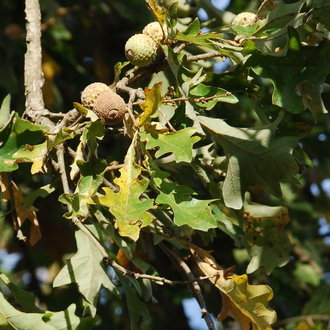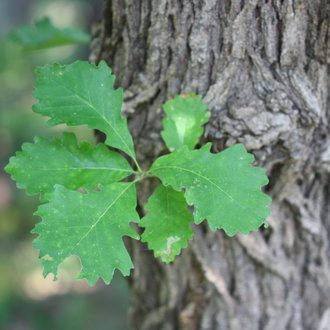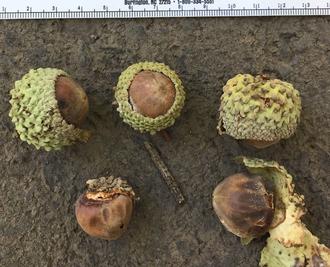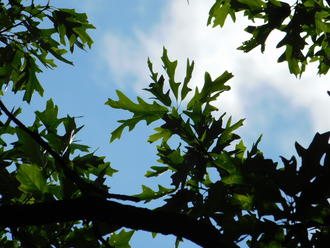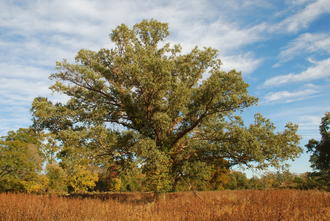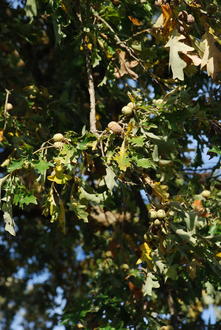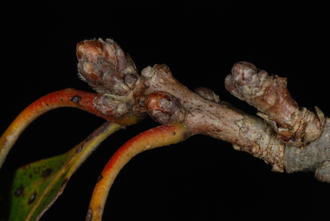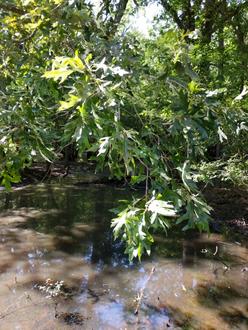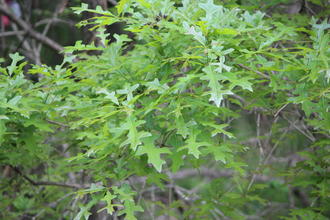Overcup Oak (Quercus lyrata Walter)
Also known as swamp post oak, swamp white oak, water white oak.
↑Summary
An oak of seasonally flooded bottomlands in the southeastern U.S. and Mississippi alluvial plain.
↑Description & Identification
A medium-to-large deciduous tree, to 60-90 feet (18-27m), rarely over 100 feet. Leaves of mature leaves are highly variable in shape, usually 5-9 lobed and with shorter lobes and shallower sinuses between lobes, relative to most oaks. Lobe tips may be rounded, but are often pointier than typical for species of the white oak group.
Acorns have a cap usually covering between 2/3rd and nearly the entire seed.
↑Similar Plants
↑Habitat
Found on low, wet soils in floodplain forests, bottomlands, and bayous in the Mississippi Alluvial & Southeast USA Coastal Plains. Mostly found on sites that have a somewhat deeper water table, but seasonally flood for as long as 40% of the growing season.
Forms a climax community on sites where flooding kills competing species; on slightly drier sites, can be found in early successional stages, where it is replaced by other species in the absence of disturbance. Often found on recently clearcut sites, where suppresed trees take advantage of reduced competition to dominate the canopy temporarily.
Although clearcutting temporarily increases the dominance of this species, in the long-run, flood control has decreased its populations both through reducing its seed distribution and decreasing the flood-prone habitats it prefers.
↑Life Cycle
Seedlings germinate in late spring to early summer, and quickly develop a taproot, which is replaced over time by a lateral root system that is shallow and saucer-shaped, reaching to higher levels to aid in aeration when the soil is saturated.
Young seedlings have a high mortality rate, with trees frequently killed by flooding; they can also be killed by fire during dry years.
Seedlings usually grow slowly for the first 10-15 years, after which growth accerelates. Seed production begins around 25-30 years; good seed crops are produced every 3-4 years. Adult trees are highly resistant to flooding, and may even benefit from flooding from February to July.
The spongy shell of this species acorns is an adaptation to make them buoyant, aiding dispersal by water. Animals also play a role in distributing the seed, but this species relies on water for seed distribution much more than other oaks. Acorns can be carried miles by water.
Unlike most white oaks, acorns of this species tend to be dormant through the winter, only germinating in the spring. Soaking in water may hinder germination temporarily, leading them to germinate later. Germination in this species may be timed to occur after spring floodwaters recede.
Trees leaf out late in spring, an adaptation to flooding, allowing trees to remain dormant during flooded periods.
Trees may live as long as 400 years.
↑Uses
This species is sometimes used for its wood; it is considered to be lower-quality than other members of the white oak group; although most white oak wood is quite durable, this species is more prone to rot. However, it is still valued in forestry; it is often the most commercially-valuable species that can grow on wetter bottomland sites in its range.
It is occasionally planted as a landscaping tree, where it is valued for its tolerance of flooding and wet soil, and being relatively easy to grow on wet sites in its range.
↑Related Plants
This species overlaps in range with numerous other species of the white oak group.
We found conflicting research on which species are closest related. An older source claimed it to be most closely related to post oak (Quercus stellata), but a more comprehensive 2017 study found it is probably most closest-related to swamp white oak (Quercus bicolor), another wetland oak which has a mostly non-overlapping, more northerly distribution, although the two species do occur together in a small area of southern Illinois, western Kentucky and Tennesee, and southeast Missouri. It also is closely related to bur oak (Quercus macrocarpa), which also has a more northerly range but overlaps slightly.
It hybridizes in the wild with many white oaks, including white oak (Quercus alba), swamp white oak, bastard oak (Quercus sinuata), bur oak, swamp chestnut oak (Quercus michauxii), post oak, and live oak (Quercus virginiana).
↑Links & External Resources
• Overcup Oak | The Wood Database (About This Site)
• Overcup Oak | Fire Effects Information System (FEIS) (About This Site)
• Quercus lyrata (Overcup Oak) | USDA PLANTS Database (About This Site)
• Quercus lyrata (Overcup Oak) | Missouri Botanical Garden Plant Finder (About This Site)
• Overcup Oak | Virginia Tech Dendrology Factsheets (About This Site)
• Overcup Oak | Silvics of North America (About This Site)
• Quercus lyrata | Biota of North America Project (BONAP) (About This Site)
• Quercus lyrata | NatureServe Explorer (About This Site)
• Quercus lyrata | Flora of North America (About This Site)
• Quercus lyrata | Missouri Plants (About This Site)
• Overcup Oak | Maryland Biodiversity Project (About This Site)
• Quercus lyrata Walter (Overcup Oak) | Digital Atlas of the Virginia Flora (About This Site)



